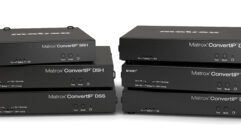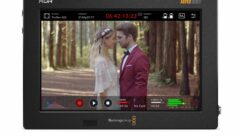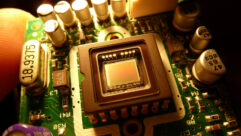
Video Review: Digital Projection iVision 30-WUXGA-XB
Mar 1, 2009 12:00 PM,
By Jeff Sauer
Lightweight, single-chip DLP projector packs a quality punch.

The front-projection industry is awash with 7.5lb. projectors. In fact, there are — by far — more 6lb.-to-10lb. models than any other class, and the price competition is often fierce. Yet very few of those ultraportables boast a native WUXGA resolution, and even fewer have a huge piece of glass hanging off the front. These are two features that should be tip-offs thatDigital Projection’s iVision 30-WUXGA-XB is no standard 7.5lb., single-chip DLP, me-too business projector.
Admittedly, with the exception of that disproportionately large lens on the front, the iVision 30 looks very similar to many of those typical 7.5lb. models in its modest-appearing, albeit magnesium, gray chassis. And this model’s native WUXGA resolution and six-segment, RGBCYW color wheel with a white segment for added brightness actually target a conference room and public-entertainment market similar to some of those much, much lower-priced DLP 7.5-pounders. However, Digital Projection isn’t targeting the exact same conference rooms or entertainment venues as those lower-cost models, but rather the very high end of the spectrum of conference rooms, night clubs, etc.
Yes, that $18,495 price is correct for the iVision 30-WUXGA-XB that I tested (specific dealer prices may vary). However, when you turn on the iVision 30 — particularly if compared side-by-side with other projectors — the real differences quickly become clear. It’s about the picture.
Specific prices vary greatly across the range of 18 different iVision 30 resolution, color-wheel, and lens configurations offered by Digital Projection. There are six SXGA+ (1400×1050) versions, eight 1080p (1920×1080) models, and four WUXGA (1920×1200) configurations. And there are four different color-wheel options and at least two lens options per resolution class. The WUXGA unit that I tested had a standard-throw-ratio lens of 1.6-2.0:1, although a 0.95:1 short-throw lens is also available. And while the RGBCYW color wheel I looked at did an excellent job with video, the iVision 30-WUXGA-XC models with an RGBCMY six-segment color wheel are more appropriate for straight-video, controlled-ambient-light, screening-room installations.
Inputs vary slightly across the iVision 30 series, with the SXGA+ and WUXGA models substituting a second 15-pin D-sub for the second RVA analog component input of the motion-video-oriented 1080p models. All models include at least one input for 15-pin, 3×RCA component, DVI-I, HDMI, S-Video, composite signal, and USB.
More importantly, all the models give knowledgeable installers very deep control over the image and color. Gamma presets afford an easy level of adjust for different source material. But it’s the built-in image calibration and correction — used in combination with Digital Projection’s ColorMax submenu — that shows the exact measured values on both the x and y axis, as well as luminance, for red, green, and blue. Output and gain adjustment for each allows for very exacting color control across the entire image. Drilling down into the sync-control adjustments means that the iVision can be configured to accept a variety of signal types. In my experience with the iVision, this ultimately means more hands-on configuration than you’d expect from today’s highly automated sync-adjusting models, but the payoff is worth it.
Digital Projection does offer an anamorphic lens options, although that would be more appropriate to the 1080p, screening-room-oriented iVision 30 models. In the case of the WUXGA models, installation and security features — such as a built-in daily/weekly timer for automatic power up/down, pin-code access, RS-232 (in/out), and Ethernet RJ-45 for external control, a presenter’s remote with laser pointer — have a more direct appeal to business settings.
Video Review: Digital Projection iVision 30-WUXGA-XB
Mar 1, 2009 12:00 PM,
By Jeff Sauer
Lightweight, single-chip DLP projector packs a quality punch.
MORE EQUAL THAN OTHERS
Out of the box, the color-calibration setup on the iVision 30 was excellent, belying the single-chip imaging device. Not only were the primary colors strong and accurate, but the secondary colors — as well as subtle shades across the spectrum — were also very accurate. And Digital Projection’s configuration tools allow you to maintain that degree of color accuracy to very specific room or installation environments.
Related Links

What are the choices an AV professional has to make when determining what projector to install in a given space? There are many, of course, but they certainly…

Video Review: Epson PowerLite Pro G5350NL
Epson has been a leader in integrating projectors into digital infrastructures for almost a decade, with wired and wireless networking capabilities that…

Video Review: Casio Super Bright XJ-S57
Casio is probably not the company that first comes to mind when you think about projectors. Nor are you likely to think of projection before watches,…
On the test bench, the iVision 30 fared just as well. Admittedly, the native 1920×1200 pixels help a great deal when it comes to maintaining the sharpness of a variety of tough test patterns. Yet resolution by itself is no panacea for handling a variety of source inputs, and I’d put the iVision’s scaling ability in a class beyond even its admittedly expensive price. More impressively to me, in the course of working with the iVision, I had normally jaded lay viewers who have seen a good number projectors comment on what a good picture it was — both in terms of sharpness and color.
As with any projector these days, Digital Projection lists a set of brightness and contrast specifications. Frankly, I don’t really know how they were measured — nor do I particularly care, and neither should you. I actually found iVision 30 brightness specs ranging from 2500 lumens to 3100 lumens and contrast as high as 4000:1. But with a projector like this, there’s no reason to mess with the picture just to play the spec number game — and I didn’t try. Under normal viewing settings I measured brightness at roughly 2500 ANSI lumens, although that obviously varied depending on settings. More importantly, I viewed content in the middle of the afternoon on a sunny day with no shades drawn, and the image looked bright and crisp. Similarly, I’d put usable contrast in the 1900:1-to-2000:1 range depending on setup.
Does all that make the iVision 30 worth its $18,495 price tag? I put it straight up against a couple other projectors with different imaging engines and similar pricing that I happened to have in the lab at the same time and I came away impressed. Admittedly, the price tag means the iVision 30-WUXGA-XB isn’t for everyone. But if you need quality, the price tag here shouldn’t get in the way.
Looking at the output of the iVision 30-WUXGA-XB reminded me of a conversation I had with a Texas Instruments (TI) DLP expert more than 10 years ago, when the technology was still fairly young and focused heavily on bright business presentations. I was begrudging the poor video quality and color accuracy of typical DLP single-chip models, and the TI representative said, “There’s no reason why a single-chip-and-color-wheel combination can’t produce excellent color. The micromirrors and the color wheel can turn more than fast enough.” Finally, after more than a decade of reviewing numerous single-chip DLP projectors, I’ve seen one that proved he was correct.
Video Review: Digital Projection iVision 30-WUXGA-XB
Mar 1, 2009 12:00 PM,
By Jeff Sauer
Lightweight, single-chip DLP projector packs a quality punch.
PRODUCT SUMMARY
- Company: Digital Projection
www.digitalprojection.com - Product: iVision 30-WUXGA-XB
- Pros: Stunning picture; excellent color for any imaging technology, but especially a single-chip DLP.
- Cons: Price.
- Applications: Any high-end conference room or public-entertainment venue where quality outweighs budget concerns.
- Price: $18,495
SPECIFICATIONS
- Resolution: WUXGA (1920×1200)
- Brightness: 3100 ANSI lumens
- Contrast: 4000:1 full on/off
- Native resolution: 1080p (1920×1080)
- Configuration: One 0.7in. DarkChip 3 DMD
- Light source: 300W UHP lamp (rated 1700 hours, 2200 hours in low mode)
- Lens: Manual focus
- Zoom: Manual 1.6-2.0:1 optical zoom
- Projection distance: 5ft.-33ft.
- Screen size: 2.5in.-18in. diagonal
- Keystone: Vertical ± 20°
- Loudspeakers: N/A
- Dimensions: 3.5″×10.9″;×9.6″ (H×W×D)
- Weight: 7.5lbs.
- Warranty: One year parts and labor










